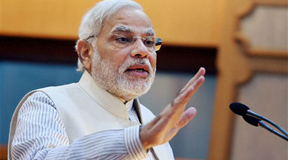 NEW DELHI: After reviewing the price situation, Prime Minister Narendra Modi today took stock of the scenario in energy sector which has been dogged pending decision on gas prices, subsidies and fuel supply issues.
NEW DELHI: After reviewing the price situation, Prime Minister Narendra Modi today took stock of the scenario in energy sector which has been dogged pending decision on gas prices, subsidies and fuel supply issues.
Modi was appraised of the problems and pending issues facing the world’s fourth largest energy consumer when Oil Minister Dharmendra Pradhan and Power and Coal Minister Piyush Goyal made PowerPoint presentations on their sectors.
He was presented the current energy scenario as well as the near and medium term outlook and goals, sources said.
Modi had over the past two days reviewed food prices and agriculture scenario in the country.
Sources said near term decisions, described as low hanging fruits that would reverse the almost stagnant investment cycle in the energy sector, and broad roadmap for medium term were presented in the presentations.
Modi’s attention was drawn to the urgency of a decision on gas price revision which was to happen on April 1 but got postponed because of general elections.
While oil and gas operators like Reliance Industries and BP have been pressing for implementing the decision taken by the previous UPA government to almost double the current USD 4.2 gas price with implementation of the Rangarajan formula, user ministries in power and fertilizer have opposed it as it would lead to hike in electricity charges and urea rates.
Fuel shortages facing power plants and inadequacy of transmission networks that have led to the current power crisis, were highlights of the presentation by Goyal and his Secretary P K Sinha. .
For coal sector, streamlining of procedures for environment clearance for coal mining while raising output from current mines as well as by opening new blocks were highlighted.
Besides gas pricing, changes in production sharing contract and fuel pricing reforms to cut subsidy outgo were highlight of the presentation made by Oil Secretary Saurabh Chandra.
The ministry and RIL are engaged in legal fight over reasons for natural gas output from D1&D3 fields in KG-D6 block falling to a tenth of planned 80 million standard cubic meters per day, a development that cast shadow on the entire investment climate.
For the next five years, the ministry has suggested fixing a target for raising domestic production of crude oil and natural gas by at least 25 per cent and adding 25 million tonnes of refining capacity.
All of the sedimentary area in the country needs to be mapped for oil and gas as also setting up of a National Gas Grid, extending supply of Euro-IV fuel all over the country and making operational at least one transnational pipeline to bring gas from Iran, Oman or Central Asia are other targets the ministry lists.–PTI






